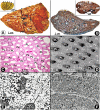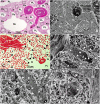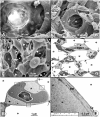Morphological and morphometric specializations of the lung of the Andean goose, Chloephaga melanoptera: A lifelong high-altitude resident
- PMID: 28339478
- PMCID: PMC5365123
- DOI: 10.1371/journal.pone.0174395
Morphological and morphometric specializations of the lung of the Andean goose, Chloephaga melanoptera: A lifelong high-altitude resident
Abstract
High altitude flight in rarefied, extremely cold and hypoxic air is a very challenging activity. Only a few species of birds can achieve it. Hitherto, the structure of the lungs of such birds has not been studied. This is because of the rarity of such species and the challenges of preparing well-fixed lung tissue. Here, it was posited that in addition to the now proven physiological adaptations, high altitude flying birds will also have acquired pulmonary structural adaptations that enable them to obtain the large amounts of oxygen (O2) needed for flight at high elevation, an environment where O2 levels are very low. The Andean goose (Chloephaga melanoptera) normally resides at altitudes above 3000 meters and flies to elevations as high as 6000 meters where O2 becomes limiting. In this study, its lung was morphologically- and morphometrically investigated. It was found that structurally the lungs are exceptionally specialized for gas exchange. Atypically, the infundibulae are well-vascularized. The mass-specific volume of the lung (42.8 cm3.kg-1), the mass-specific respiratory surface area of the blood-gas (tissue) barrier (96.5 cm2.g-1) and the mass-specific volume of the pulmonary capillary blood (7.44 cm3.kg-1) were some of the highest values so far reported in birds. The pulmonary structural specializations have generated a mass-specific total (overall) pulmonary morphometric diffusing capacity of the lung for oxygen (DLo2) of 0.119 mlO2.sec-1.mbar-1.kg-1, a value that is among some of the highest ones in birds that have been studied. The adaptations of the lung of the Andean goose possibly produce the high O2 conductance needed to live and fly at high altitude.
Conflict of interest statement
Figures









Similar articles
-
Respiratory mechanics and morphology of Tibetan and Andean high-altitude geese with divergent life histories.J Exp Biol. 2018 Jan 10;221(Pt 1):jeb170738. doi: 10.1242/jeb.170738. J Exp Biol. 2018. PMID: 29180602
-
A morphometric analysis of the lungs of high-altitude ducks and geese.J Anat. 2020 Jul;237(1):188-196. doi: 10.1111/joa.13180. Epub 2020 Mar 15. J Anat. 2020. PMID: 32173858 Free PMC article.
-
High thermal sensitivity of blood enhances oxygen delivery in the high-flying bar-headed goose.J Exp Biol. 2013 Jun 15;216(Pt 12):2172-5. doi: 10.1242/jeb.085282. Epub 2013 Mar 7. J Exp Biol. 2013. PMID: 23470665
-
An allometric study of pulmonary morphometric parameters in birds, with mammalian comparisons.Philos Trans R Soc Lond B Biol Sci. 1989 Nov 30;326(1231):1-57. doi: 10.1098/rstb.1989.0104. Philos Trans R Soc Lond B Biol Sci. 1989. PMID: 2575769 Review.
-
High-altitude champions: birds that live and migrate at altitude.J Appl Physiol (1985). 2017 Oct 1;123(4):942-950. doi: 10.1152/japplphysiol.00110.2017. Epub 2017 Aug 24. J Appl Physiol (1985). 2017. PMID: 28839002 Free PMC article. Review.
Cited by
-
Evolution of physiological performance capacities and environmental adaptation: insights from high-elevation deer mice (Peromyscus maniculatus).J Mammal. 2019 May 23;100(3):910-922. doi: 10.1093/jmammal/gyy173. J Mammal. 2019. PMID: 31138949 Free PMC article.
-
Convergent changes in muscle metabolism depend on duration of high-altitude ancestry across Andean waterfowl.Elife. 2020 Jul 30;9:e56259. doi: 10.7554/eLife.56259. Elife. 2020. PMID: 32729830 Free PMC article.
-
Unidirectional airflow, air sacs or the horizontal septum: what does it take to make a bird lung?Philos Trans R Soc Lond B Biol Sci. 2025 Feb 27;380(1920):20230418. doi: 10.1098/rstb.2023.0418. Epub 2025 Feb 27. Philos Trans R Soc Lond B Biol Sci. 2025. PMID: 40010391 Free PMC article. Review.
-
Structure and function of the avian respiratory system.Philos Trans R Soc Lond B Biol Sci. 2025 Feb 27;380(1920):20230435. doi: 10.1098/rstb.2023.0435. Epub 2025 Feb 27. Philos Trans R Soc Lond B Biol Sci. 2025. PMID: 40010395 Review.
-
Migratory songbirds exhibit seasonal modulation of the oxygen cascade.J Exp Biol. 2023 Sep 1;226(17):jeb245975. doi: 10.1242/jeb.245975. Epub 2023 Aug 29. J Exp Biol. 2023. PMID: 37534524 Free PMC article.
References
-
- Gehr P, Mwangi DK, Ammann A, Maloiy GMO, Taylor CR, Weibel ER. Design of the mammalian respiratory system: V. Scaling morphometric diffusing capacity to body mass: wild and domestic animals. Respir Physiol. 1981; 44:61–86. - PubMed
-
- White CR, Kearney MR. Metabolic scaling in animals: methods, empirical results and theoretical explanations. Comp Physiol. 2014; 4:231–256. - PubMed
-
- Black CP, Tenney SM. Oxygen transport during progressive hypoxia in high altitude and sea level water-fowl. Respir Physiol. 1980; 39:217–239. - PubMed
MeSH terms
LinkOut - more resources
Full Text Sources
Other Literature Sources
Molecular Biology Databases

